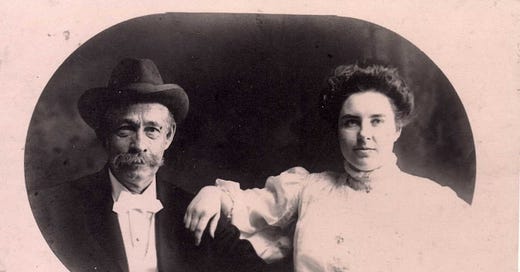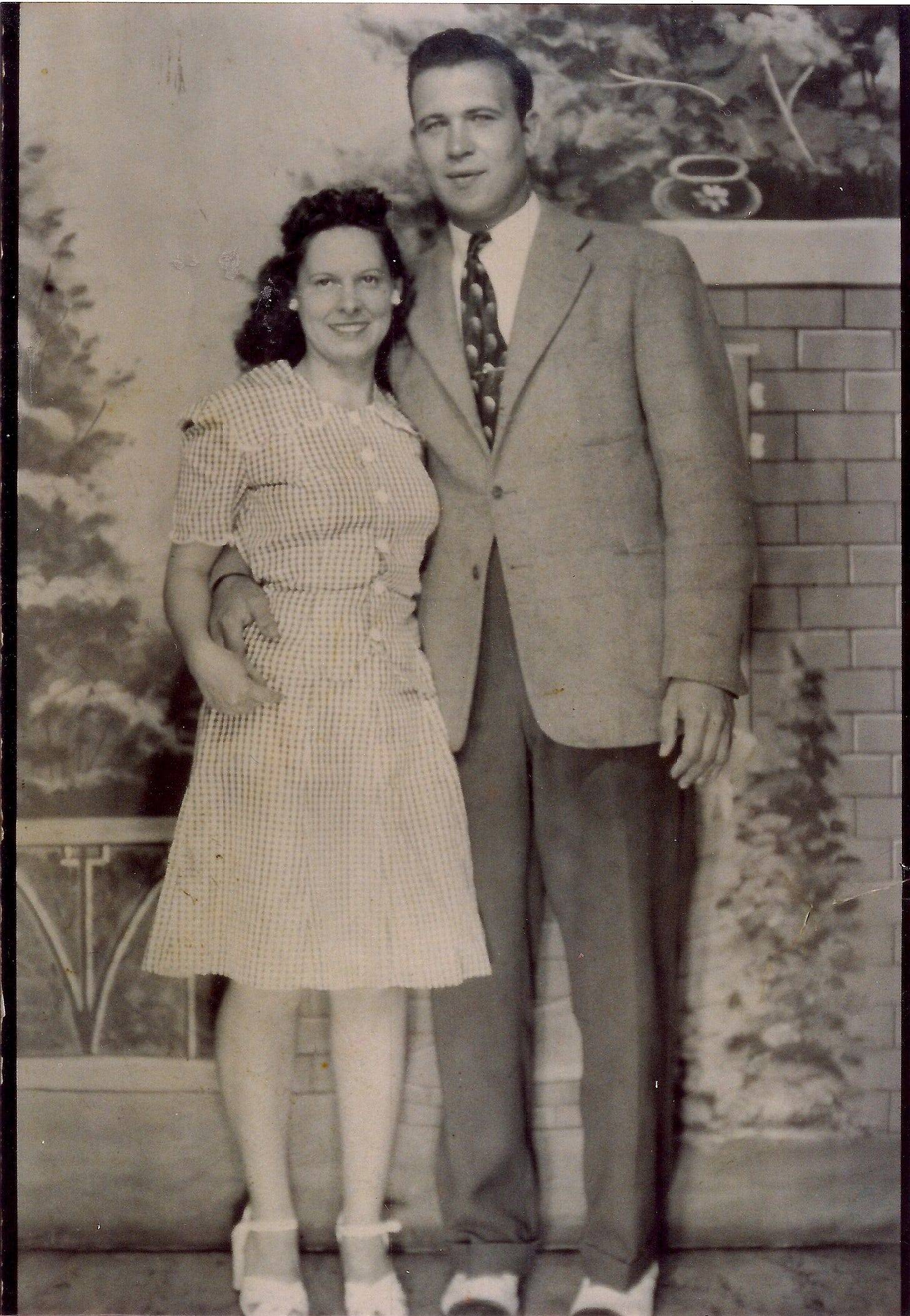Richard Zimmerman: World War II Sailor
When our identity is taboo, it is too easy to be erased from history
Note: much of this post is adapted from “You Just Can’t Matcham,” posted on my old Mightier Acorns blog on November 11, 2016. If you are interested in this family, I included a lot more information about George and Emma’s children in that original post.
George Delorain Matcham (1844–1923) was born in Pittsfield, Lorain County, Ohio, to Edward and Abigail (Tinker) Matcham, both of whom had come to Ohio from Massachusetts. Edward was born in Pittsfield, Berkshire County, Massachusetts, in 1812, and he arrived in what would be called Pittsfield, Ohio, in 1830. He and Abigail were school teachers in neighboring townships.
According to a 1951 article in Elyria's "The Chronicle-Telegram" on the history of schools in Lorain County:
"Pittsfield's first school was taught by Miss Minerva Loveland in a small cabin erected for educational purposes. In 1831 or 1832 Edward Matcham began his period of teaching which lasted 10 years. Miss Abagail Tinker was the first teacher in Rochester Township. She conducted her school in a log cabin during the Winter of 1833-1834."
Edward and Abigail were married on 8 April 1835. They had a daughter, Mary, in 1841; their only son, George, followed in 1844. George was never a very healthy boy, and he had to drop out of his studies at the college at Oberlin because of his health problems. Still, he was a bright young man, and after he managed to complete a course at the business school at Oberlin, he took out patents on improvements he made in farm equipment, which helped establish him as a businessman.
In 1871, George married his first wife, Marion Worcester (1840–1906). George served on the school board for a time and kept up his patents for income. The couple continued to live in Pittsfield until 1895 when they moved to Oberlin. Soon after coming to Oberlin Mr. Matcham invested in land at Linwood Park on Lake Erie and helped to develop the resort. He built several cottages there and had spent his summers there for several years. Marion helped run the 19-room inn they built there until she died in 1906.
Emma Beatrice Callin (1885–1951) married George the following year. Emma was the fourth child of John H and Amanda (Walker) Callin. She grew up in a house with a Civil War hero father, a pioneer mother, five brothers, and her grandmother, who died in 1903. She married when she was 22 years old and George was 63 - just two years younger than Emma's father. I suspect the two men were at least friends if not business partners.
In the decade and a half they were married, George and Emma had five children. They continued to live off of their inn, and Emma hosted social life in the resort on Lake Erie. Sadly, George died in 1923, when their youngest daughter was only four years old. Emma's mother, Amanda, had been living with the family for several years by then and probably helped with the children.
Five years after George died, Emma married Gustav Heimsath (1888–1963) on 10 December 1928. Gus was an engineer whose family hailed from Germantown, Pennsylvania, near Philadelphia. After Amanda died in 1933, and the children began to leave home, Gus and Emma moved to the Cleveland area, where Emma died in 1951.
Ruth Ellen Matcham Heimsath (1919–2009) was the youngest of George and Emma’s five children. She was so small when her father died, that she only really knew her step-father, Gus Heimsath. She grew up and married Richard R. "Zimmy" Zimmerman (1924–2009) in February 1946, and they had two children, both of whom are still living. Ruth began using her stepfather's surname and was known as Ruth Heimsath until she died in 2009.
The Truth About Zimmy
Richard Roland Zimmerman was the son of Roland H Zimmerman (1899–1980) and Helen J Smith (1899–1980), born on 11 Feb 1924 in Salem, Columbiana County, Ohio. He grew up in Perry, Columbiana County, and enlisted in the U.S. Navy on 12 Jan 1942. He served aboard submarines during 1942 and early 1943, when he was discharged on 3 Mar 1943 under the Navy's policy against homosexuality. He returned to Salem, and after a run-in with the law, he was able to find work.
Richard married Ruth Ellen Heimsath in Feb 1946 in Salem, Columbiana County, Ohio. Ruth and Richard had a son and a daughter together, but soon after Ruth's mother died, Richard left her and she found she was pregnant with a third baby. She gave her two children to the family across the street to raise because she could not work and care for them at the same time. When her third child was born, Ruth put her up for adoption. (I don’t have records for these events; a surviving relative gave me this information.)
After his divorce from Ruth in the 1950s, Richard does not appear in available records until 1968. He married Nancye Bernice (Easely) Spicher (1940–2011) on 18 Jul 1969 in Clark County, Nevada, and they lived in Downey, Los Angeles County, California. They also had a daughter, Tracye G. (Zimmerman) Smith (1968-2018), whom they raised in Salem, Columbiana County, Ohio. Richard and Nancye divorced in 1997.
Things We Know
Records can tell us a lot while also leaving a lot out. I’ve got a pretty good timeline of Richard Zimmerman’s World War II service thanks to the U.S., World War II Navy Muster Rolls, 1938-1949 records on Ancestry.
He enlisted in the U.S. Navy on 12 Jan 1942 at Cleveland, Ohio. His service number (283-68-76) helped distinguish his records from those of other men with similar names. His rating was “A.S.” for Aviation Support Equipment Technician.
After he finished training, Richard traveled aboard the USS President Adams (AP-38) in Feb 1942 from Tampa, Florida, to the Panama Canal Zone. He transferred on 19 Feb to the Submarine Base at Coco Solo. A month later, on 19 Mar 1942, he boarded the USS Bonita (SS-165). From 5 Apr 1942, he was temporarily transferred to USS Antaeus (AS-21), returning to the Bonita on 24 May 1942, having advanced in rating to F3c (Fireman 3rd class).
On 28 Nov 1942, F3c Zimmerman was transferred to the submarine base at New London, Connecticut. He shipped out on 1 Dec 1942 aboard the USS R-9 for a brief trip down to the U.S. Naval Station at Key West, Florida, then transferred to the USS R-14 on 16 Dec 1942.
Finally, on 3 Mar 1943, his record shows that he was discharged "from U.S. Navy with undesirable disch. in accordance with SecNav. conf. ltr. 83443 dated 1/1/43."1
If you read SecNav letter 83443, it appears evident that Richard was investigated by his commander, and confronted with a choice. The language “with undesirable discharge” suggests that as an enlisted man, Richard was asked to accept the discharge with no further charges being pressed.
Things We Don’t Know
Given the gaps in Richard’s biography and the sensitivities of discussing homosexuality in the 1940s, we could read a lot into his story. That incident leading to his discharge may have been an isolated event, or it could indicate that he led a life in which he hid part of himself from those closest to him. I imagine he was embarrassed and angry—angry enough to attempt a crime.
One night in January 1944, while working as a cab driver, Richard broke into the Ohio Restaurant on E. State St. in Salem. Police making their rounds at 2 a.m. startled him, and he ran through the glass front door, cutting his wrist. He got away, but when he found his way back to where he had left his car, it was gone. He was captured when he phoned the police to report it stolen. They had taken the car to the station after Richard fled the scene of the burglary. To add insult to injury, Richard had initially only found $30 and two cartons of cigarettes, which he had stashed in the car before the police arrived. He had gone back into the restaurant to look for more when the patrol showed up.
This incident seems to have discouraged future malfeasance, at least while he was married to Ruth. Considering the abruptness of his divorce from Ruth, and the fact that we don’t know where he was for nearly twenty years afterward leaves a lot of open questions.2 That he married again and had another child tells us something about his journey—but what it tells us depends on other unknowns.
From this point, all we can do is keep an open mind and respect who Richard was—whether we ever find out the facts or not. What we cannot do is erase him, or those like him, from our history.
Perhaps one day—hopefully sooner than later—it will be safe for everyone to be who they truly are. Until then, all we can do is use the strength that empathy gives us to take care of each other.
According to his obituary, “He had resided in California for 23 years before returning to Salem. Before his retirement he had worked as a tool and die maker at Warren Molded Plastics for eight years and had previously worked at Paxson Machine.”






Hi Tad! I love reading your informative and thoughtful posts about the Callin/Matcham family and all its branches. Just a slight correction in this article: only 1 of Ruth and Richard’s children is still alive - their youngest daughter who was put up for adoption. My mother, Sally and her brother, Richard passed away in 2012 and 2014, respectively. The picture you have with this story is of my uncle Richard Roland, Jr. There are pictures of his father, Richard Roland, in my ancestry tree and you are free to use them if you like. Cheers!
I'm a bit confused about his service history - mostly the rating (jobs) he did. It seems a little strange to me he went from an Aviation support person to Fireman on a submarine. Did you get his OMPF from NPRC or are you relying on Muster Rolls? Since you have his discharge with his serial number it sounds like you traced him accurately but is still strange. Did his service file give reasons why he trained in aviation and then was transferred?
I'm a professional WWII researcher which is why I'm asking. I've seen interesting and strange things in all military files so I'm always curious. I'm currently writing a brief bio on one Naval man in WWII for a local museum exhibit. This man - in the Navy - had service in Germany. Sounds crazy but I did some research and the Navy brought in Landing Craft to help build bridges across the Rhine River after the Germans blew bridges. I had no idea the Navy went inland until I saw his file. There is always something new to learn.